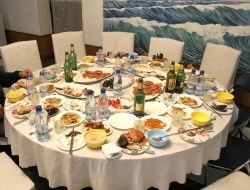Chongjin - the city of Iron
HOW TO GET THERE | CHONGJIN | KYONGSONG | MAP | CUISINE | HOTELS & RESTAURANTS | AROUND CHONGJIN | OUR TOURS
Chongjin (the Chinese characters for its name mean 'clear river crossing') is the country's third largest city which is home for about 627,000 people. Chongjin is the DPRK’s second-largest industrial city featuring an array of factories, mills, towering chimneys and spindly black cranes. Chongjin has been nicknamed "The City of Iron" for its six million tonne-capacity Kim Chaek No 1 Iron and Steel Complex.
Originally a fishing village, Chongjin underwent massive growth during the 20th century as the Japanese made it into a major port and industrial city, producing steel, machinery and chemical fibres, building its grid of roads to serve those ends and its population of what was, by 1945, some 300,000 people. Around two-thirds of that number survived the US shells and bombs of the Korean War.
During the Russo-Japanese War of 1904-1905, Japanese forces landed at Chongjin, and established a supply base due to its proximity to the front lines in Manchuria. The Japanese remained after the end of the war, and in 1908, declared the city an open trading port both for transport of Korean resources and as a stopping point for resources from China. The city was known during this period as “Seishin”, after the Japanese pronunciation of the Chinese characters for its name.
The Imperial Japanese Army’s 19th Division was headquartered in Ranam from 1918, where the Japanese built a new planned city based on a rectangular street grid. In the 1930, Nippon Steel built a large steel mill, the Seishin Iron and Steel Works, in the town. Ranam was annexed to Chongjin in 1940, which was elevated to city status. The city was overrun after a brief resistance by the Soviet Union on August 13, 1945, only a couple of days before the end of World War II.
Today Chongjin remains important military and industrial city.
The People's Republic of China and Russia have set up their Consulates in Chongjin. Chongjin is estimated to have a 24 percent share of the DPRK's foreign trade. The Chinese consul serves Chinese merchants and businesspersons operating in the north east of the country, and Russian consul issues visas for local workers (mostly lumberjacks) temporarily working in the Russian Far East.
How to get there
Chongjin is 788 km from Pyongyang. Due to the road condition it takes about 3 days to get from Pyongyang to Chongjin by road. At the same time it takes about 30 h to get to Chongjin from Pyongyang by train due to frequent power cut offs and slow train speed. From Rajin (Rason) the road to Chongjin takes about 3 h.
The best way to get from Pyongyang to Chongjin is to take flight to Orang - Chongjin Airport (IATA: RGO), a small airport located approximately 40 kilometres from Chongjin. Chongjin Airport is equipped with a 2,000 m (6,600 ft) runway on a military and civilian dual purpose air station (CHO). North Korea planned to upgrade the airport so that it would have a 4,000 m (13,000 ft) runway, and would act as the nation's second international airport. However, it is still not yet completed.
Chongjin
Even though Chongjin is the 3rd largest city in the DPRK it is almost never visited by foreigners. Chongjin is an important military and industrial center - there are many heavy industrial complexes, two ports (East and West port) and number of tourist attractions: Pohanng Square with 25-foot bronze statues of great leaders, Chongjin Revolutionary Museum, North Hamgyong Province Theater, Inmin Daehakseup Dang (Grand People's Study House).
Chongjin is the only city in North Korea other than Pyongyang to operate a tram system. These trains are all second-hand from Pyongyang. Originally, it was planned to be a 32 km (20 mi) system, but only phase 1,6 km (3.7 mi), and phase 2,7 km (4.3 mi), were completed. Phase 3,8 km (5.0 mi), was not completed due to lack of funds. Also, due to electricity shortages, the trams run infrequently. Besides trams, trolley buses also operate, but these are operated only two hours a day. Private taxis do not exist. The main road, called Road No. 1, is a six lane highway that intersects the city.
New monuments in Chongjin
On the occasion of 66th anniversary of the DPRK foundation on September 9, 2014 Chongjin held an enormous celebration ceremony during which new monuments of the great leaders were revealed.
Chongjin Electronic Library
Provincial Museum of Revolutionary Activities of Comrade Kim Il Sung
On display in the museum are materials about the revolutionary activities of President Kim Il Sung, leader Kim Jong Il and mother Kim Jong Suk. A bronze statue of President Kim Il Sung stands in the plaza in front of the museum situated in the center of Phohang district, Chongjin. The 3-storey museum on a floor space of 9,210 square meters has 46 exhibition rooms. It was inaugurated on October 10, Juche 58 (1969).
Kim Chaek No 1 Iron and Steel Complex
Chongjin is dominated by its huge steelworks. The Kim Chaek Iron and Steel Complex is North Korea's largest steel mill, with an annual production of six million tons of steel and iron, or about half of North Korea's total steel production. Japan's Mitsubishi Cooperation established the Chongjin Ironworks this location during the colonial period in 1938, and its scale was later expanded under Kim Il Sung's policy of emphasizing heavy industry in the mid-1950's and 1960s. In 1975, the Soviet Union provided technology and equipment for steel, hot and cold rolled steel production. The Soviet Union provided further assistance during the 1980s, but after the collapse of the USSR Russia stopped supplying coke needed for the strength of iron and steel.
Chongjin Port
Chongjin's port has established itself as an important componenent of busy international shipping trade with neighbouring parts of Northeast and Southeast Asia. Of DPRK's eight international shipping ports, Chongjin is thought to be second most economically significant (after Nampho port on the west coast) and serves as a base of trade to Russia and Japan. Chongjin also boasts a seamen's club which caters to foreign crews and is used as a meeting base for North Koreans and foreigners engaged in the shipping trade.
Chongjin Steelworks Kindergarten
One of the best kindergartens in the country.
Kyongsong
Kyongsong is a famous hot spa resort had a ceramic production center. The city is located 35 km southwest of Chongjin. There are several places of interest: Kyongsong Town Fort, South Gate, Confucian School and Jongbuk Temple. Kyongsong is well-known for its own specialities like Kyongsong ceramics, Kyongsong Hot Spa and Kyongsong matrimony vine.
Yombun Revolutionary Site
It is a place where President Kim Il Sung and Kim Sung and Kim Jong Suk came taking young Kim Jong Il along with them, and gave on-site guidance. Lying 4 km from Kyongsong Town, the place is called Yombunjin as salt was made there in the past. On September 25, Juche 36 (1947) President Kim Il Sung talked with the fishermen calling them to building a new country. The places where he talked with the fishermen and where he posed for a photograph, the rocky islet where he visited by boat, the site where he fished, a spring and Kyesung Peak which young Kim Jong Il climbed are preserved well.
Jipsam Revolutionary Site
Jipsam is a historic place where the anti-Japanese heroine Kim Jong Suk, together with young Kim Jong Il, visited, talked with fishermen and showed them the way to building a more civilized prosperious country. In Jipsam there is a monument to her revolutionary activities. You also can visit sites No.1 and 2 where she talked with the fishermen and demonstrated her marks-manship. There is also a branch of the Kyongsong Revolutionary Museum here.
Kyongsong Town Fort and South Gate
North Korean National Treasure No. 118.
This is perhaps the only intact city wall in North Korea. The town's South gate is separately registered as National Treasure No. 119. Built in a plain area during the Koryo dynasty, the fort is in the Sungam workers' district. It was built in 1107. Its circumference is 2,200 m, 7.2 m high fort has 7 batteries, and on its top there are 560 small walls for shooting arrows. There were gates in the north, south, east and west, but at present only the South Gate remains. The South Gate has all the general characteristics of the Korean fort gates built during the Li dynasty. The pavilion on the gate has traverse beams, but it preserves its majestic shape as a fort gate. In the past barracks, armory, food storage, government office and dwelling houses were within around the fort and 3.5 m wide and 4.5 m deep moat was around the fort. The Kyongsong Fort and South Gate were used as a strong point defending the north of the country and played an important role in defeating the foreign invaders during the Imjin Patriotic War.
Kyongsong Hot Spa
The Spa contains simple silica (carbonic acid, hydrocarbonic acid, sulphuric acid and natrium) strong alkalic and weak radon hot spa, It is in Haonpho workers' district 2 km away from Kyongsong Town. The spa is effective for internal and external diseases, but more effective for chronic gastroenteritis, stomach and duodenum ulcer, chronic bronchitis, silicosis, mercury and lead poisoning, chronic sulphide carbonic acid poisining, obesity and light diabetis. Kim Jong Suk Sanatorium is situated here. Covering an area of 300 ha the sanatorium has facilities for hot bathing, warm bathing, sand bathing, curative exercise and physical threatment.
Onpho Hot Spa
The spa contains hydrocarbonic acid, sulphuric acid natrium, silica and small amount of minerals. It is 12 km northwest of Kyongsong Town. The spa is effective for rheumatism, neuralgia, high blood pressure, women;s diseases, gas or lead poisoning, chronic colitis, after effect of operations, duodenum ulcer and stomach ulcer.
Main Attractions and Map of Chongjin Area
1. Chongjin Railway Station |
6. Kyongsong |

|
Cuisine / Food
Chongjin's most famous product is dried squid.
Hotels & Restaurants
In Chongjin area there are several accommodation options:
- Chongjin Hotel - The big attraction is the sauna and on-site brewery. Please refer to our hotel page for the details
- Kyongsong Tourist Hotel - Standing in Haonpho workers' district about 2km of Kyongsong Town, the hotel has fine lodging and service facilities. There are about 40 rooms. This hotel is famous for its sea food. The Kyongsong Hot Spa water is provided to each room of the hotel so that the guests can bath in hot spa water every day without ever going to the spa
Around Chongjin
- Rason - Free Economic Zone Rason, located at the border with Russia and China. Rason is a national policy firing field for the DPRK where it conducts economic field experiments such as for example free market for local companies and farms (in Rajin there is the only market in the DPRK which foreigners can legally visit).
- Mt.Chilbo - one of the five celebrated mountains of Korea. There are a million stories about the Mt.Chilbo and the rock formations, which guides are happy to share with tourists. Many of these stories have special charm so that some tourists have nominated Mt.Chilbo to be "the sexiest mountain of Korea".
Our Tours including Chongjin
We have group and individual tours visiting Chongjin. Drop us a message to check what options are available for you: postmaster@koreakonsult.com









































































